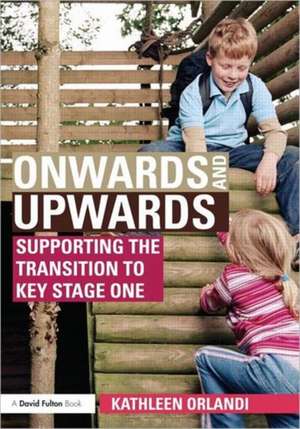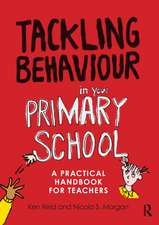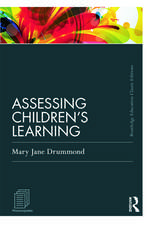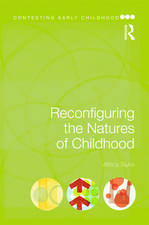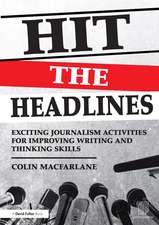Onwards and Upwards: KS 1
Autor Kathleen Orlandien Limba Engleză Paperback – 28 sep 2011
This book introduces the concept of transition and identifies the key problem areas for children and adults focusing on the differences in philosophy and practice between the EYFS and Key Stage One, whilst also giving emphasis to the opportunities that are provided by the transition process.It stresses the need for a balanced approach and the importance of sustained shared thinking from the EYFS through Key Stage One and provides practical strategies for achieving this.
Onwards and Upwards: Supporting the Transition to Key Stage One includes detailed guidance on:
- preparing for the transition to Key Stage One
- the role of the teacher
- the balance between adult-led and child initiated activity
- play and the use of the outdoor environment
- creating a stimulating environment that supports a balanced approach
| Toate formatele și edițiile | Preț | Express |
|---|---|---|
| Paperback (1) | 205.20 lei 6-8 săpt. | |
| Taylor & Francis – 28 sep 2011 | 205.20 lei 6-8 săpt. | |
| Hardback (1) | 762.89 lei 6-8 săpt. | |
| Taylor & Francis – 28 sep 2011 | 762.89 lei 6-8 săpt. |
Preț: 205.20 lei
Preț vechi: 256.27 lei
-20% Nou
Puncte Express: 308
Preț estimativ în valută:
39.27€ • 42.64$ • 32.99£
39.27€ • 42.64$ • 32.99£
Carte tipărită la comandă
Livrare economică 22 aprilie-06 mai
Preluare comenzi: 021 569.72.76
Specificații
ISBN-13: 9780415612432
ISBN-10: 0415612438
Pagini: 120
Ilustrații: 3 b/w images, 10 tables and 11 line drawings
Dimensiuni: 174 x 246 x 245 mm
Greutate: 0.23 kg
Ediția:New.
Editura: Taylor & Francis
Colecția Routledge
Locul publicării:Oxford, United Kingdom
ISBN-10: 0415612438
Pagini: 120
Ilustrații: 3 b/w images, 10 tables and 11 line drawings
Dimensiuni: 174 x 246 x 245 mm
Greutate: 0.23 kg
Ediția:New.
Editura: Taylor & Francis
Colecția Routledge
Locul publicării:Oxford, United Kingdom
Public țintă
Postgraduate and ProfessionalCuprins
Chapter One: Introduction The overall aims of the book The nature of the research which informs much of the book What about transition? ? Chapter Two: What are the issues for children? Getting the children’s perspectives on issues of transition right Examples of brief interviews with children about their transition from Reception Class to Year One What issues do children have with transition from Foundation Stage to Year One? So what are the children telling us about their needs for transition to Year One? Children identified as having special educational needs ? ? Chapter Three: What are the issues for parents and practitioners? What are the issues about transition for parents? Issues identified by teachers in three case study settings ? ? Chapter Four: Preparation or practice? What happens during preparation for transition? This looks at two aspects: establishing familiarity and consideration of practice, using three case study settings as examples. The impact of changing practice as part of transition. This compares Reception Class and Year One practice in the three case study settings, and includes the children’s perspectives. ? Chapter Five: The features of successful transition between Reception Class and Year One This first part of the chapter lists the features of successful transition between Reception Class and Year One. This is intentionally brief as it leaves the reflection to the reader. The second part of the chapter has case studies of two boys who transferred from the same Reception Class into different Year One Classes. The case studies provide an opportunity to examine their differing experiences. The chapter concludes with a table for teachers to use to reflect on their provision ‘Transition Check for Reception and Year One Teachers Chapter Six: Why should Foundation Stage practice be introduced to Year One? This chapter attempts to justify the transformation of practice in Year One a) to aid transition and b) because it is more suitable for the way young children learn. It examines the issue of supporting learning and development through play in Year One. Chapter Seven: A principled approach to planning in Year One This chapter briefly examines the principles for planning in Year One that allow 1) children to meet the expectations of national guidelines and 2) age appropriate experiences that will support the development of positive dispositions to learning. The second part of the chapter considers some examples of planning frameworks for Year One that 1) provide suitable experiences for the children and 2) take into consideration the need to check children’s progress against national requirements. ? Chapter Eight: Moving to Year One – opportunity for continuity and for change Opportunities for reflection, development and children’s rights
Notă biografică
Kathleen Orlandi is Senior Lecturer in Childhood Studies at Liverpool Hope University. She is also Lead Manager of the North West Early Years Transformation Group (NWEYTG), which provides courses for candidates wishing to achieve Early Years Professional Status.
Descriere
How can teachers ensure that the transition from the Early Years Foundation Stage to Key Stage One is a positive experience for children? What are the issues for children, parents and teachers and how should teachers respond to these?
This book introduces the concept of transition and identifies the key problem areas for children and adults focusing on the differences in philosophy and practice between the EYFS and Key Stage One, whilst also giving emphasis to the opportunities that are provided by the transition process.It stresses the need for a balanced approach and the importance of sustained shared thinking from the EYFS through Key Stage One and provides practical strategies for achieving this.
